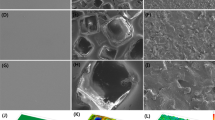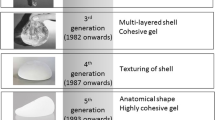Abstract
Background
As the most principal complication following breast augmentation with silicone breast implants, capsular contracture is greatly influenced by surface texture. However, there have long been widespread debates on the function of smooth or textured surface implants in reducing capsular contracture.
Materials and Methods
Three commercially available silicone breast implants with smooth and textured surfaces were subjected to surface characterization, and in vitro and in vivo assessments were then implemented to investigate the effect of these different surfaces on the biological behaviors of fibroblasts and capsular formation in rat models.
Results
Surface characterization demonstrated that all three samples were hydrophobic with distinct roughness values. Comparing the interactions of fibroblasts or tissues with different surfaces, we observed that as surface roughness increased, the adhesion and cell spreading of fibroblasts, the level of echogenicity, the density of collagen and α-SMA-positive immunoreactivity decreased, while the proliferation of fibroblasts and capsule thickness increased.
Conclusions
Our findings elucidated that the effect of silicone implant surface texture on fibroblasts’ behaviors and capsular formation was associated with variations in surface roughness, and the number of myofibroblasts may have a more significant influence on the process of contracture than capsule thickness in the early stage of capsular formation. These results highlight that targeting myofibroblasts may be wielded in the prevention and treatment strategies of capsular contracture clinically.
Level of Evidence V
This journal requires that authors assign a level of evidence to each article. For a full description of these Evidence-Based Medicine ratings, please refer to the Table of Contents or the online Instructions to Authors www.springer.com/00266.








Similar content being viewed by others
References
International Society of Aesthetic Plastic Surgery (2020) ISAPS International Survey on Aesthetic/Cosmetic Procedures Performed in 2019. (2020-12-09) [2021-09-20]. https://www.isaps.org/wp-content/uploads/2020/12/Global-Survey-2019.pdf.
International Society of Aesthetic Plastic Surgery (2018) ISAPS International Survey on Aesthetic/Cosmetic Procedures Performed in 2017. (2018-11-01) [2021-09-20]. https://www.isaps.org/wp-content/uploads/2019/03/ISAPS_2017_International_Study_Cosmetic_Procedures_NEW.pdf.
Adams WP Jr (2009) Capsular contracture: what is it? What causes it? How can it be prevented and managed? Clin Plast Surg 36:119–126
Handel N, Cordray T, Gutierrez J, Jensen JA (2006) A long-term study of outcomes, complications, and patient satisfaction with breast implants. Plast Reconstr Surg 117:757–767
Headon H, Kasem A, Mokbel K (2015) Capsular contracture after breast augmentation: an update for clinical practice. Arch Plast Surg 42:532–543
Hakelius L, Ohlsén L (1992) A clinical comparison of the tendency to capsular contracture between smooth and textured gel-filled silicone mammary implants. Plast Reconstr Surg 90:247–254
Cash TF, Duel LA, Perkins LL (2002) Women’s psychosocial outcomes of breast augmentation with silicone gel-filled implants: a 2-year prospective study. Plast Reconstr Surg 109:2112–2121
Prantl L, Pöppl N, Horvat N, Heine N, Eisenmann-Klein M (2005) Serologic and histologic findings in patients with capsular contracture after breast augmentation with smooth silicone gel implants: is serum hyaluronan a potential predictor? Aesthetic Plast Surg 29:510–518
Derby BM, Codner MA (2015) Textured silicone breast implant use in primary augmentation: core data update and review. Plast Reconstr Surg 135:113–124
Chao AH, Garza R 3rd, Povoski SP (2016) A review of the use of silicone implants in breast surgery. Expert Rev Med Devices 13:143–156
Harvey AG, Hill EW, Bayat A (2013) Designing implant surface topography for improved biocompatibility. Expert Rev Med Devices 10:257–267
Barnsley GP, Sigurdson LJ, Barnsley SE (2006) Textured surface breast implants in the prevention of capsular contracture among breast augmentation patients: a meta-analysis of randomized controlled trials. Plast Reconstr Surg 117:2182–2190
Poeppl N, Schreml S, Lichtenegger F, Lenich A, Eisenmann-Klein M, Prantl L (2007) Does the surface structure of implants have an impact on the formation of a capsular contracture? Aesthetic Plast Surg 31:133–139
Wong CH, Samuel M, Tan BK, Song C (2006) Capsular contracture in subglandular breast augmentation with textured versus smooth breast implants: a systematic review. Plast Reconstr Surg 118:1224–1236
Tandon VJ, DeLong MR, Ballard TN, Clemens MW, Brandt KE, Kenkel JM, Cederna PS (2018) Evolving trends in textured implant use for cosmetic augmentation in the United States. Plast Reconstr Surg 142:1456–1461
Li XH, Zhou X, Chen Y, Yu S, Chen X, Xia X, Shi XH, Zhang YM, Fan DL (2017) Surface changes of nanotopography by carbon ion implantation to enhance the biocompatibility of silicone rubber: an in vitro study of the optimum ion fluence and adsorbed protein. J Mater Sci Mater Med 28:167
Zhou X, Chen X, Mao TC, Li X, Shi XH, Fan DL, Zhang YM (2016) Carbon ion implantation: a good method to enhance the biocompatibility of silicone rubber. Plast Reconstr Surg 137:690e–699e
Heidekrueger PI, Sinno S, Hidalgo DA, Colombo M, Broer PN (2018) Current trends in breast augmentation: an international analysis. Aesthet Surg J 38:133–148
Calobrace MB, Schwartz MR, Zeidler KR, Pittman TA, Cohen R, Stevens WG (2017) Long-term safety of textured and smooth breast implants. Aesthet Surg J 38:38–48
Lista F, Austin RE, Saheb-Al-Zamani M, Ahmad J (2020) Does implant surface texture affect the risk of capsular contracture in subglandular breast augmentation and breast augmentation-mastopexy? Aesthet Surg J 40:499–512
Munhoz AM, Clemens MW, Nahabedian MY (2019) Breast Implant Surfaces and Their Impact on Current Practices: Where We Are Now and Where Are We Going? Plast Reconstr Surg Glob Open 7:e2466
Williams DF (1987) Definitions in Biomaterials. Elsevier, Amsterdam
Menzies KL, Jones L (2010) The Impact of Contact Angle on the Biocompatibility of Biomaterials. Optom Vis Sci 87:387–399
Prasad BR, Brook MA, Smith T, Zhao S, Chen Y, Sheardown H, D’Souza R, Rochev Y (2010) Controlling cellular activity by manipulating silicone surface roughness. Colloids Surf B Biointerfaces 78:237–242
Provenzano PP, Keely PJ (2011) Mechanical signaling through the cytoskeleton regulates cell proliferation by coordinated focal adhesion and Rho GTPase signaling. J Cell Sci 124:1195–1205
Carpenter J, Khang D, Webster TJ (2008) Nanometer polymer surface features: the influence on surface energy, protein adsorption and endothelial cell adhesion. Nanotechnology 19:505103
Lampin M, Warocquier-Clérout R, Legris C, Degrange M, Sigot-Luizard MF (1997) Correlation between substratum roughness and wettability, cell adhesion, and cell migration. J Biomed Mater Res 36:99–108
Kang IK, Ito Y, Sisido M, Imanishi Y (1989) Attachment and growth of fibroblast cells on polypeptide derivatives. J Biomed Mater Res 23:223–239
Tamada Y, Ikada Y (1994) Fibroblast growth on polymer surfaces and biosynthesis of collagen. J Biomed Mater Res 28:783–789
Tolksdorf J, Horch RE, Grüner JS, Schmid R, Kengelbach-Weigand A, Schubert DW, Werner S, Schneidereit D, Friedrich O, Ludolph I (2020) Size matters-in vitro behaviour of human fibroblasts on textured silicone surfaces with different pore sizes. J Mater Sci Mater Med 31:23
Biggs MJ, Richards RG, Dalby MJ (2010) Nanotopographical modification: a regulator of cellular function through focal adhesions. Nanomedicine 6:619–633
Valencia-Lazcano AA, Alonso-Rasgado T, Bayat A (2014) Physico-chemical characteristics of coated silicone textured versus smooth breast implants differentially influence breast-derived fibroblast morphology and behaviour. J Mech Behav Biomed Mater 40:140–155
Bettinger CJ, Langer R, Borenstein JT (2009) Engineering substrate topography at the micro- and nanoscale to control cell function. Angew Chem Int Ed Engl 48:5406–5415
Valencia-Lazcano AA, Alonso-Rasgado T, Bayat A (2013) Characterisation of breast implant surfaces and correlation with fibroblast adhesion. J Mech Behav Biomed Mater 21:133–148
Mascharak S, Benitez PL, Proctor AC, Madl CM, Hu KH, Dewi RE, Butte MJ, Heilshorn SC (2017) YAP-dependent mechanotransduction is required for proliferation and migration on native-like substrate topography. Biomaterials 115:155–166
Green AM, Jansen JA, van der Waerden JPCM, von Recum AF (1994) Fibroblast response to microtextured silicone surfaces: texture orientation into or out of the surface. J Biomed Mater Res 28:647–653
Fischer S, Hirche C, Reichenberger MA, Kiefer J, Diehm Y, Mukundan S Jr, Alhefzi M, Bueno EM, Kneser U, Pomahac B (2015) Silicone Implants with Smooth Surfaces Induce Thinner but Denser Fibrotic Capsules Compared to Those with Textured Surfaces in a Rodent Model. PLoS One 10:e0132131
Atlan M, Nuti G, Wang H, Decker S, Perry T (2018) Breast implant surface texture impacts host tissue response. J Mech Behav Biomed Mater 88:377–385
Bui JM, Perry T, Ren CD, Nofrey B, Teitelbaum S, Van Epps DE (2015) Histological characterization of human breast implant capsules. Aesthetic Plast Surg 39:306–315
Darby I, Skalli O, Gabbiani G (1990) Alpha-smooth muscle actin is transiently expressed by myofibroblasts during experimental wound healing. Lab Invest 63:21–29
Abramo AC, De Oliveira VR, Ledo-Silva MC, De Oliveira EL (2010) How texture-inducing contraction vectors affect the fibrous capsule shrinkage around breasts implants? Aesthetic Plast Surg 34:555–560
Kim BH, Park M, Park HJ, Lee SH, Choi SY, Park CG, Han SM, Heo CY, Choy YB (2017) Prolonged, acute suppression of cysteinyl leukotriene to reduce capsular contracture around silicone implants. Acta Biomater 51:209–219
Park RH, Pollock SJ, Phipps RP, Langstein HN, Woeller CF (2019) Discovery of novel small molecules that block myofibroblast formation: implications for capsular contracture treatment. Plast Reconstr Surg Glob Open 7:e2430
Park S, Park M, Kim BH, Lee JE, Park HJ, Lee SH, Park CG, Kim MH, Kim R, Kim EH, Heo CY, Choy YB (2015) Acute suppression of TGF-ß with local, sustained release of tranilast against the formation of fibrous capsules around silicone implants. J Control Release 200:125–137
Persichetti P, Segreto F, Carotti S, Marangi GF, Tosi D, Morini S (2014) Oestrogen receptor-alpha and -beta expression in breast implant capsules: experimental findings and clinical correlates. J Plast Reconstr Aesthet Surg 67:308–315
Elrefaie AM, Salem RM, Faheem MH (2020) High-resolution ultrasound for keloids and hypertrophic scar assessment. Lasers Med Sci 35:379–385
Spear SL, Baker JL Jr (1995) Classification of capsular contracture after prosthetic breast reconstruction. Plast Reconstr Surg 96:1119–1123
Petitclerc L, Sebastiani G, Gilbert G, Cloutier G, Tang A (2017) Liver fibrosis: review of current imaging and MRI quantification techniques. J Magn Reson Imaging 45:1276–1295
Ehling J, Lammers T, Kiessling F (2013) Non-invasive imaging for studying anti-angiogenic therapy effects. Thromb Haemost 109:375–390
Baues M, Dasgupta A, Ehling J, Prakash J, Boor P, Tacke F, Kiessling F, Lammers T (2017) Fibrosis imaging: current concepts and future directions. Adv Drug Deliv Rev 121:9–26
National Research Council (U.S.) Committee for the Update of the Guide for the Care and Use of Laboratory Animals (2011) Guide for the Care and Use of Laboratory Animals, 8th edn. National Academies Press, Washington, D.C.
Funding
This research was funded by a grant from the National Natural Science Foundation of China (Grant Number: 81873940).
Author information
Authors and Affiliations
Corresponding authors
Ethics declarations
Conflict of interest
The authors declare that they have no conflicts of interest that could have appeared to influence the work reported in this paper.
Human and Animal Rights
The animal experimental protocols utilized in this study were approved by the Institutional Animal Care and Use Committee of the Army Military Medical University, China. This study was carried out in compliance with the Guide for the Care and Use of Laboratory Animals [51].
Additional information
Publisher's Note
Springer Nature remains neutral with regard to jurisdictional claims in published maps and institutional affiliations.
Rights and permissions
About this article
Cite this article
Huang, Sq., Chen, Y., Zhu, Q. et al. In Vivo and In Vitro Fibroblasts' Behavior and Capsular Formation in Correlation with Smooth and Textured Silicone Surfaces. Aesth Plast Surg 46, 1164–1177 (2022). https://doi.org/10.1007/s00266-022-02769-y
Received:
Accepted:
Published:
Issue Date:
DOI: https://doi.org/10.1007/s00266-022-02769-y




